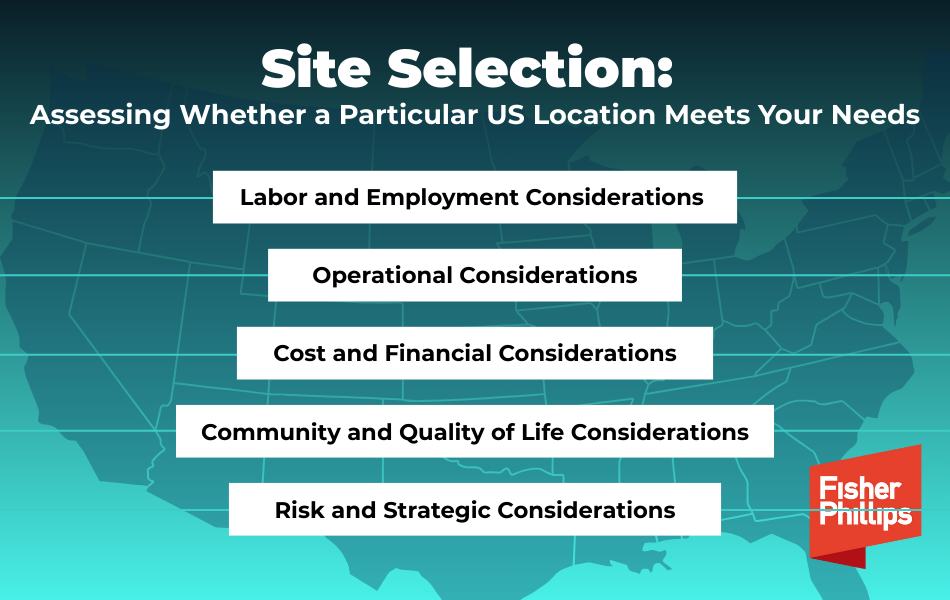Site Selection Checklist for Companies Expanding Operations or Entering the US
Insights
9.19.25
Many companies are accelerating US expansion or entry plans due to favorable policy shifts, rising demand for domestic supply chains, and shifting population dynamics. For example:
- Over the past decade, companies have announced nearly $200 billion in investments in electric vehicles (EV) and battery manufacturing facilities.
- In the semiconductor sector, 2025 will see around 18 new fabrication construction projects begin across the Americas and Japan; many more are expected to begin production in 2026-27.
- Southern and Southeastern states continue to grow rapidly. Florida has added 900,000 residents since 2023, while North Carolina gained approximately 350,000 in the same period and South Carolina’s population grew by 1.5%. Meanwhile, Texas just won the 2025 Prosperity Cup, awarded by Site Selection magazine, recognizing its top ranking among states in new and expanded facility projects, capital investment, job creation, business and tax climate, and workforce readiness.
But the variabilities involved in large scale investment – considering federal, state, and local incentives, shifting demographics, and many other factors – mean that companies need to carefully evaluate if a potential landing site makes strategic, operational, and financial sense. The following checklist will help you assess whether a particular US location is suitable for expansion or entry.

1. Labor and Employment Considerations
|
_____ |
Will there be sufficient qualified employees to support the new location? |
|
_____ |
Is there information on local occupations as rates of the applicable labor force? |
|
_____ |
What are the educational levels within the hiring pool? |
|
_____ |
What are the trends in the available workforce over the past five or 10 years? Is the labor pool growing or shrinking? |
|
_____ |
What local educational resources are available to help train your workforce now and into the future? |
|
_____ |
Will the local post-secondary educational institutions create or modify educational programs to meet your company’s needs (use of robotics and AI in your operations)? |
|
_____ |
What type of regulatory environment prevails in the proposed location? This can include such areas as safety, workers’ compensation, anti-discrimination, leave management, and unemployment. |
|
_____ |
Is there an existing employer in a similar line of business or with similar business processes (e.g., IT or accounting) that might compete for workers? |
|
_____ |
What’s the outlook for current and future workforce competition? Are local businesses expanding or are new businesses coming into the area resulting in additional competition for workers? |
|
_____ |
What is the unionization environment and history of labor activity? |
|
_____ |
Are there workforce development partnerships (apprenticeships, vocational training, job centers) available? |
2. Operational Considerations
|
_____ |
Are there sufficient crucial suppliers within reasonable travel times? |
|
_____ |
Are there restrictive zoning requirements on the proposed site as well as adjacent properties? |
|
_____ |
How accessible is the proposed location to existing company operations in the region? |
|
_____ |
Can you reach existing and new customers efficiently? |
|
_____ |
Are there existing buildings/offices or greenfield sites available for development? |
|
_____ |
Is there room for future expansion as needed? |
|
_____ |
Will there need to be infrastructure improvements to meet your company’s needs (airports with good connections, road or rail service, port access, and intermodals, etc.)? |
|
_____ |
Will you have access to sufficient levels of gas, electricity, potable water, sewer and waste handling, and emergency services to support your operations? |
|
_____ |
What type of renewable energy sources are available for the site (wind, solar, etc.)? |
|
_____ |
What are the permitting and approval timelines for site development or facility expansion? |
|
_____ |
Are there restrictive regulations on air and wastewater emissions or wetlands mitigation requirements? |
|
_____ |
How reliable are the logistics networks (congestion, weather disruptions, labor strikes at ports, etc.)? |
3. Cost and Financial Considerations
|
_____ |
What is the overall cost of doing business in this location (real estate, utilities, insurance, transportation)? |
|
_____ |
What are the state and local corporate, income, property, and sales tax burdens? |
|
_____ |
Are there property tax abatements, investment tax credits, job tax credits, cash grants, etc., available in the proposed area? |
|
_____ |
Is there a minimum level of investment or job creation needed to obtain incentives? Is there a risk of clawbacks? |
|
_____ |
What are average wage levels and benefits costs compared to other peer markets? |
|
_____ |
What are the hidden or long-term costs (compliance, environmental remediation, local fees)? |
|
_____ |
Does the region offer financial predictability (e.g., stable tax policies, no sudden incentive clawbacks)? |
4. Community and Quality of Life Considerations
|
_____ |
Is the proposed region desirable for workers (i.e., affordable housing, good schools, and recreational opportunities) – especially for those who might transfer from existing operations? |
|
_____ |
What is the availability and affordability of healthcare services? |
|
_____ |
How attractive is the region to new talent (arts, culture, amenities, diversity, climate)? |
|
_____ |
Are there relocation support services for families (spousal employment assistance, international schools, etc.)? |
|
_____ |
What is the community’s track record welcoming and retaining major employers? |
5. Risk and Strategic Considerations
|
_____ |
Is the site vulnerable to natural disasters, severe weather, or the negative impacts of climate change (hurricanes, ice storms, floods, wildfires, sink holes, earthquakes)? |
|
_____ |
How stable is the political, judicial, and regulatory environment? |
|
_____ |
Are there reputational risks associated with locating in the region (litigation climate, environmental controversies)? |
|
_____ |
Does the location align with corporate ESG/sustainability goals? |
|
_____ |
What is the long-term strategic fit? Does the region position the company well for future expansions, shifts in customer demands, or shifts in supply chains? |
Conclusion
We will continue to monitor developments related to site selection activities and offer updates as necessary, so make sure you are subscribed to Fisher Phillips’ Insight System to keep up with the most up-to-date information. Please contact your Fisher Phillips attorney, the authors of this Insight, or any attorney on our Site Selection and Incentives Team or International Practice Group with any questions.
Related People
-
- Raymond W. Perez
- Of Counsel
Service Focus
- Counseling and Advice
- Employment Discrimination and Harassment
- International
- Labor Relations
- Site Selection and Incentives

